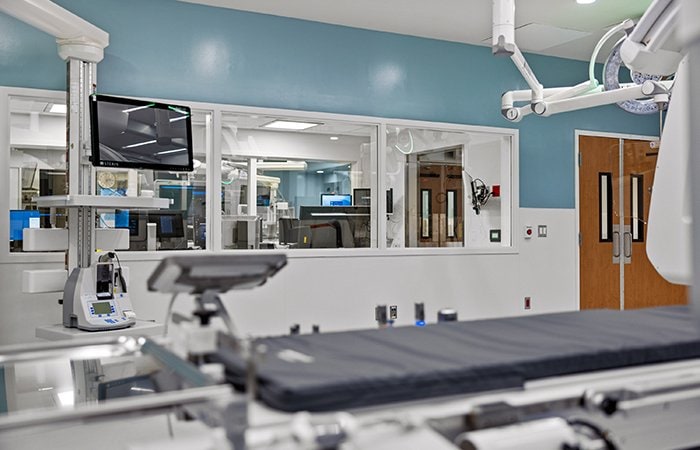This project enhances procedures we already provide and enables us to develop others, such as our endovascular surgery program.
—Dr. Steven Cabrales, Vice President and Chief Medical Officer of Montage Health
Hybrid ORs marry the advanced imaging technology used in minimally invasive procedures with the features of a surgical suite. This creates a single environment that can be used for traditional “open” surgeries, with larger incisions to access the surgical site, and transcatheter procedures which are done through small incisions, guided by the imaging systems.
“This project enhances procedures we already provide and enables us to develop others, such as our endovascular surgery program,” says Dr. Steven Cabrales, Vice President and Chief Medical Officer of Montage Health.

The hybrid ORs replace two cardiac catheterization laboratories (cath labs) and will continue to be home to a range of heart procedures, including opening blocked arteries, replacing valves, and repairing other heart defects. The advanced technology will also allow the addition of new transcatheter procedures, including minimally invasive mitral valve interventions for the treatment of leaky mitral valves.
A “leak” is what prompted development of the hybrid ORs; a major flood caused water damage in one of the cath labs, jump-starting renovation plans. “We took the opportunity when disaster struck and said, ‘Let’s not only develop a state-of-the-art cath lab, but let’s also make it OR-capable for the future,’” Cabrales says.
That future includes endovascular procedures to treat problems in blood vessels, like aortic aneurysm repair, and, eventually, neurovascular procedures, like breaking up or removing blood clots from the brain. There could also be procedures that involve both open surgery and minimally invasive interventions on the same patient. For example, a patient with blockages in both the leg and the pelvis might be treated with a surgical bypass in the leg and a catheter-placed stent in the pelvis, all during one session in a hybrid OR.
Such procedures will benefit from the hybrid ORs’ “phenomenal” imaging, says Julie Rush, RN, director of Community Hospital’s Tyler Heart Institute. The system uses a robotic arm that can move around the procedure table to capture images from just about any angle, in 2D and 3D. One of the hybrid ORs has a “biplane” X-ray system that gives doctors real-time visualization from two angles, needed for certain interventions.
The system scans faster than the previous technology and each image covers a bigger area of the body; both factors mean patients need less of the intravenous contrast used for the imaging. Other elements of hybrid ORs can also contribute to patient safety and successful outcomes:
-
If a procedure can be done using a minimally invasive technique, the patient may need only mild sedation rather than general anesthesia which can be more taxing for some patients, especially the elderly
-
Hospital stays and recovery times are generally shorter with minimally invasive procedures
-
If something unexpected happens during a minimally invasive procedure and open surgery is required, it can be done in the same room, rather than stopping the procedure and moving the patient to an OR
Outcomes can also be improved by the collaborative approach that a successful hybrid OR requires, says Dr. Ahmad Edris, Director of Interventional Cardiology and Structural Heart Disease at Montage Medical Group. Procedures planned for the hybrid ORs will draw on the expertise of broad teams of surgeons, interventional cardiologists, radiologists, anesthesiologists, nurses, and others.
“At Community Hospital, we have already established a multidisciplinary heart team with TAVR (transcatheter aortic valve replacement) as well as mitral valve interventions, and I believe the same can be done with vascular and endovascular care,” Edris says.
In a TAVR procedure, a faulty heart valve is replaced with a new valve using a catheter inserted through a small incision in the leg artery, rather than through open-heart surgery. Before every TAVR, the prospective patient is evaluated by a multidisciplinary heart team including an interventional cardiologist and a cardiac surgeon to determine which approach is best — open surgery or in a cath lab.
“The future of medicine in general is really a collaborative approach, a multidisciplinary approach,” Edris says. “It’s not just one physician determining the best care of the patient. We decide as a team what is the best modality to treat each patient. We look at the data and comprehensively evaluate the patient. It’s knocking down the silos traditionally found in medicine.”
The hybrid ORs are the first in Monterey County and are usually only found in larger communities or at academic medical centers.
“Community hospitals don’t usually have these kinds of things,” Edris says. “This automatically results in the recruitment of physicians who have skill sets that can add to the community, and also add to the skill sets of our staff to better treat our patients.”